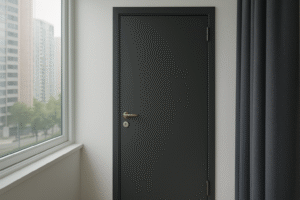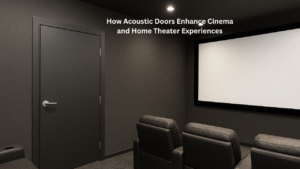Introduction: Why Noise Barriers Matter in a Noisy World
Noise pollution is an often-overlooked threat to public health, quality of life, and urban sustainability. Exposure to high noise levels can cause sleep disorders, stress, cardiovascular issues, and reduced cognitive performance, particularly in children. As cities grow and traffic intensifies, implementing an effective noise barrier becomes crucial for protecting residents, enhancing urban living conditions, and fostering a healthier, quieter environment.
One of the most effective ways to reduce unwanted sound, especially from highways, railroads, industrial zones, and construction sites, is by installing a highway noise barrier. Also known as sound walls, acoustic barriers, or sound fences, these structures work by blocking, absorbing, reflecting, or diffracting sound waves, thereby reducing the number that reach nearby communities. Over decades of research, engineers and acousticians have developed a variety of highway noise barriers, each designed to meet specific site conditions, traffic levels, and environmental requirements.
In this article, we’ll explore the main types of noise barriers, their advantages and disadvantages, how to choose the right one, and the role of acoustic design in maximizing performance.
Different Types of Noise Barriers (With Pros & Cons)
Here are the most commonly used noise barrier types, along with their characteristics, pros, and limitations.
1. Concrete Noise Barriers
Key Features & Typical Uses
Concrete barriers are among the most common and extensively used in highway, urban, and residential settings. They are often precast panels or cast-in-place walls. Their density and rigidity make them effective at blocking sound transmission.
Advantages
- High sound transmission loss (they block a large portion of noise)
- Durable and long-lasting with low maintenance
- Good for large-scale linear installations (e.g., along highways)
- Can be molded into aesthetic shapes, patterned, or textured
Disadvantages
- Heavy and structurally demanding (requires strong foundations)
- Generally, reflective surfaces (they bounce sound back)
- More expensive to install initially
- Less effective at absorbing sound (reflections can cause secondary noise)
- Visual “canyon effect” and possible aesthetic objections
Concrete walls remain among the most cost-justified options where space and budget allow.
2. Metal Noise Barriers (Steel, Aluminum, etc.)
Design & Common Applications
Metal barriers are typically made of steel or aluminum, sometimes perforated or with added absorptive panels. They may include modular panels that are bolted together.
Advantages
- Lightweight relative to concrete
- Modular and easier to install or retrofit
- Can include perforations or absorptive backing to reduce reflections
- More adaptable for curved roads or irregular layouts
Disadvantages
- Corrosion or weathering over time (unless properly treated)
- Usually less mass, and thus less blocking power, unless thick or composite
- If untreated, they tend to reflect noise strongly
- Maintenance for coatings, fasteners, and structural supports
3. Transparent (Acrylic / Polycarbonate / Glass) Barriers
Where They Are Used & Why
Transparent barriers are often used in areas where maintaining visibility is desirable, such as alongside scenic routes, residential zones with views, or urban streetscapes.
Benefits
- Maintain sight lines and reduce the “visual barrier” effect
- Less visually obstructive and more aesthetically acceptable
- Can reduce perceived enclosure and shadowing effects
Potential Drawbacks
- More expensive materials
- Vulnerable to scratching, vandalism, or maintenance issues
- Optical clarity may degrade over time (yellowing, dirt)
- Less mass than concrete, so may require thicker panels or backing
- Glare, reflection, or safety concerns if glass is used
4. Wooden Noise Barriers
Design & Sustainability Aspects
Wooden barriers are made from timber or engineered wood products. They are often used in rural, suburban, or semi-natural settings where aesthetics and ecological integration are valued.
Advantages
- Natural look that blends with the surroundings
- Less industrial appearance
- Renewable and potentially lower carbon footprint
- Can be combined with absorptive materials or vegetation
Disadvantages
- Susceptible to rot, insects, and moisture damage
- Requires regular maintenance (coatings, replacement)
- Lower durability compared to concrete or metal
- Lower sound-blocking unless made thick or with backing
5. Earth Berms (Natural / Earthen Noise Barriers)
Construction & Functionality
An earth berm is a raised mound or embankment of soil, often with a sloped front face, built between a noise source and a receiver. Sometimes called “acoustic berms,” they act as massive absorptive or blocking elements.
Benefits
- Very high mass and thickness, providing significant attenuation
- Blends well with natural landscapes
- Low maintenance
- Can support vegetation to further reduce reflection
Limitations
- Requires a lot of land and space
- Construction costs and earth-moving can be high
- Not practical in tight urban/highway corridors
- Limited flexibility in shape once built
6. Green Walls / Vegetative Noise Barriers
Eco-Friendly Design & Use
These barriers combine structure with living vegetation such as shrubs, vines, trees, or grass. Sometimes they are built as vertical green façade walls; other times, vegetative strips are placed in front of a rigid barrier.
Benefits
- Absorb and scatter sound, especially mid-to-high frequencies
- Provide ecological and aesthetic benefits (air filtration, habitat)
- Visually pleasing and socially accepted
- Can reduce reflection and soften visual impact
Drawbacks / Maintenance Needs
- Less effective at low frequencies and very high noise levels
- Requires ongoing irrigation, pruning, and maintenance
- Takes time to grow and mature
- Potential for seasonal variation (leaf loss in winter)
- Soil, root, and structural support requirements
From research: solid sound walls combined with vegetation can help mitigate near-road air pollution, too.
7. Composite / Hybrid Noise Barriers (Hybrid Systems)
What Makes Them Unique
Composite barriers combine two or more materials (e.g., concrete + absorptive panels, metal + wood, or transparent + absorptive backing). The aim is to capture the advantages of each material and reduce the drawbacks.
Main Advantages
- Can be optimized for absorption + mass + aesthetics
- Flexible design to suit site constraints
- Better broadband performance across frequencies
- Improved performance compared to single-material barriers
Possible Disadvantages
- More complex design, engineering, and installation
- Higher cost and maintenance complexity
- Potential interface issues (junctions, seams)
Hybrid systems are increasingly used in modern highway and railway noise mitigation projects.
How to Choose the Right Type of Noise Barrier
Selecting the right noise barrier requires balancing multiple factors. Below is a checklist of key considerations:
- Noise Source & Frequency Content
- Is it highway traffic, trains, industrial equipment, or a construction site?
- Low-frequency noise requires heavy, dense materials to block effectively.
- Available Space & Setback
- Do you have enough land width to install berms or thick barriers?
- Urban corridors may restrict barrier height or footprint.
- Budget Constraints
- Materials, foundation, labor, and long-term maintenance all matter.
- Aesthetic & Visual Impact
- Transparent or vegetative barriers help preserve views.
- Local community acceptance is crucial for public projects.
- Durability & Maintenance
- Consider weather, corrosion, biological growth, and repair needs.
- Construction Complexity & Timeline
- Logistical feasibility (foundation, transport, modular construction)
- Disruption to existing infrastructure or traffic
- Acoustic Performance & Modeling
- Engineers often simulate barrier performance (sound propagation models).
- Consider absorption, reflection, diffraction, and transmission effects.
- Local Regulations & Standards
- Noise control regulations may specify minimum dB reduction or barrier heights.
- Building codes or environmental norms may apply.
For large-scale linear projects (like highways), a well-designed composite concrete or hybrid barrier often offers the best balance of performance and cost. In residential settings near scenic or natural areas, vegetative or transparent barriers may be preferred despite somewhat lower performance.
Why Choose Ecotone Systems for Reliable Noise Barrier Services
At Ecotone Systems, we specialize in designing and manufacturing high-performance noise barriers on highways that effectively reduce environmental and industrial noise pollution. With years of expertise in acoustic engineering, we deliver customized solutions for highways, railways, power plants, factories, and urban developments. Our product range includes concrete noise barriers, metal barriers, transparent panels, composite structures, and green acoustic walls that combine functionality with aesthetics. Every barrier we build is engineered for superior sound absorption, durability, and environmental sustainability, ensuring compliance with international acoustic standards. Whether you need large-scale highway noise barriers or tailored enclosures for specific applications, Ecotone Systems provides end-to-end support from design and fabrication to installation and maintenance, helping you create a quieter and safer environment.
The Role of Acoustic Design & Soundproofing in Noise Barriers
Simply having a “wall” is not enough. The acoustic design of a barrier is what determines how well it truly mitigates noise. Below are important design elements and innovations:
Absorption vs Reflection vs Diffraction
- Absorptive surfaces (using porous, fibrous, or micro-perforated materials) convert sound energy into heat, reducing reflections.
- Reflective surfaces bounce sound back, which is effective in blocking but may produce secondary noise.
- Diffraction is when sound waves “bend” over the top or around edges; barrier height and shape influence this.
A barrier must be tall enough to break the line of sight between source and receiver, minimizing diffraction. The junctions, seams, and ends must be carefully sealed or curved to prevent leakage.
Broadband Performance & Frequency Optimization
Noise is not a single frequency. A well-designed barrier functions across low, mid, and high frequencies. Composites or hybrid materials help by targeting absorption in mid/high ranges, while mass (concrete, berms) addresses low frequencies.
Computational & Optimization Techniques
Recent research has introduced advanced methods to optimize barrier shape and material distribution using computational models. For example:
- A semianalytical meshless method enables efficient optimization of barrier geometry and material distribution, resulting in better acoustic performance per material used.
- Metamaterials and sonic crystals are emerging noise control structures that utilize periodic arrangements to create band gaps in specific frequency ranges.
Such innovations may become more common in future infrastructure projects.
Maintenance & Long-Term Performance
Acoustic coatings, absorptive panels, vegetation health, and cleaning (for transparent barriers) all influence long-term performance. Designs should be planned for access and repair to maintain acoustic effectiveness over time.
Case Example: Noise Barriers in India
As an illustration, the Ahmedabad–Mumbai bullet train project is installing extensive noise barriers along stretches of the viaduct. They use concrete panels (2 m high, 1 m wide) combined with transparent polycarbonate sections in sensitive zones to preserve passenger views.
This hybrid approach shows how modern megaprojects balance acoustic performance, cost, and aesthetics in practice.
Conclusion Building Toward a Quieter Future
Noise pollution is a serious environmental and public health challenge. As urbanization and transport networks expand, implementing an effective highway noise reduction barrier becomes increasingly important. Choosing and designing the right highway noise reduction barrier, rather than just any barrier, is key to achieving significant and long-lasting sound reduction for nearby communities.
To summarize:
- Concrete, metal, transparent, wood, berms, green walls, and composite/hybrid systems each have unique strengths and trade-offs.
- The ideal choice depends on the noise source, site constraints, budget, aesthetics, and regulatory demands.
- Acoustic design absorption, reflection, diffraction, and computational modeling are what make a barrier truly effective.
- Innovations like metamaterials, sonic crystals, and optimization algorithms are pushing the envelope of what is possible.





